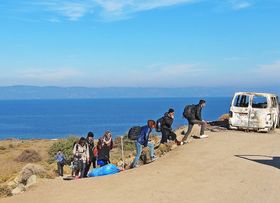
Violence, representation, violence of representations : the case of women asylum seekers and refugees in the Mediterranean Sea
September 2020 : the Moria camp, on the Greek island of Lesbos, burns. Almost 13 000 individuals were living there and left without shelter. This event triggered emotion among the public opinion and politicians, as well as a renewed interest from the media. Ever since April 2015, the European media have produced a dense though fluctuant coverage of the situation in the Mediterranean Sea of asylum seekers and refugees.
These two words are often mistaken for one another, not only in the media but even in politicians’ speeches. Amnesty International provides two clear definitions that show the legal difference of the terms. An asylum-seeker and a refugee are defined as a person who fled their country because of human rights violations and/or persecutions. However if a refugee has been granted asylum, and consequently benefits of the international protection of their status, an asylum-seeker is one still waiting for a decision regarding their asylum claim. The international frame for refugees and asylum seekers has been designed in the Geneva Convention of 1951 Relating to the Status of Refugees.
Common mistake when approaching the topic of refugees and asylum seekers is to assimilate them with migration and/or the so-called Mediterranean crisis. Seeking asylum is indeed a form of migration, but migration describes a broader phenomenon, from tourism, to expatriation. Europe’s influx of asylum seekers and refugees on its borders has dominated the debate over refugees around the world. However, the European Union is far from being the first destination for refugees. In general, refugees are displaced to the neighboring countries of their country of origin. For instance, Lebanon in 2016 hosted one million Syrian refugees, that is to say a fifth of the refugees fleeing the conflict, and has become the country “with the largest refugee population per capita in the world’’ (Yasmine and Moughalian, 2016, 27).
This article will mostly focus on Syrian, Afghan and Iraqi cases due to the fact that they are the most numerous asylum seekers arriving in Greece, one of the main ports of entry for the European Union. Indeed, 86% of the sea arrivals of January and February 2016 hailed from just ten countries, 45% of them were from Syria and 24% from Afghanistan (Freedman, 2016a, 18). This is chosen in order to be more precise and is not in any case a will to deny the heterogeneity of experiences and profiles. Even in the considered cases, no unique truth or monolithic conclusion can be drawn.
Moreover, the focus will be on women among refugees and asylum seekers for the specific violence that they encounter during the asylum and refugee process. The idea of a feminization of that process must be cautiously asserted, especially because of the lack of gender- disaggregated data. However it was estimated by the United Nation of High Commissioner for Refugees (UNHCR) in 2016 that 20% of asylum seekers arriving in the EU were women. There is no need of emphasizing the risks that the path through the Mediterranean Sea represents. In its 2019 annual report, SOS Méditerranée called the Central Mediterranean « the world’s deadliest migration axis ». All Mediterranean routes considered, 1,885 deaths were recorded, not to mention the number of missing persons, and with a probability of higher figures due to the unrecorded deaths. Adding to the existing risks, women are also targeted by gender-based violence, defined by the UNHCR as “violence that targets individuals or groups of individuals on the basis of their gender” (UNHCR, 2003, 10). But the case of women also enlightens the violence that can emerge from representation, meaning the way they are portrayed.
Personal violence : the tip of the iceberg
In his well known 1969 paper, Galtung makes the distinction between direct violence and structural violence. The main difference between the two notions is « whether or not there is a subject (person) who acts » (Galtung, 1969, 171), one who commits violent acts. Though the two notions are not disconnected, structural violence implies unequal power. In the case of women refugees and asylum seekers, both types of violence are perpetuated by a broad array of actors.
Asylum can be perceived as a process, and it is considered here that the process starts even before the departure of the individuals, when the motivation and the reasons to seek asylum arise. For women, those reasons can be similar to those of men : political oppression, war situations,… However, women’s reasons of leaving differ in the sense that conflicts are characterized by gendered and sexual violence predominantly targeting women. Thus from the very beginning of the asylum process, women face specific types of violence.The Syrian conflict has been the site of numerous gendered-base and sexual violence1, to the point where most of the Syrian women had a direct experience of violence or had a relative who experienced violence perpetrated either by ISIS, the rebels, or the official Syrian army (Freedman, 2016a, 21). Furthermore, there is a wide range of gendered-obstacles preventing women from migrating. Those are a lack of economic resources, a fear of the violence occurring during the migration process or also the responsibility for children and children’s welfare, and many others.
Direct gender-based and sexual violences are also occurring during the journey to the country of refuge, making it particularly dangerous for women.
The smugglers are acknowledged perpetrators of these violences, as they impose sexual violence and coerced sex during the journey to women. Sexual violence also occurs when it is regarded as a transaction to partly pay for the journey. During Freedman’s interviews of refugee women having reached Europe, several of them reported having been assaulted during the journey and generally women seem to have been more affected and distressed than men by the crossing, though it is possible that they communicate it more (Freedman, 2016b, 576).
These violence are also perpetrated by official figures of authority during the crossing of the border, those figures being the military, the border guards, and the humanitarian aid workers. UNHCR reported that the authority benefiting the security forces, that is to say the power they can exercise over the right of entrance of the territory, could represent a threat and enable them to exert sexual violence on women. Another sense of security and influence is also coming from humanitarian aid workers, and several cases of sexual violence have also been reported by refugees women. (UNHCR, 2003, 14-15). Thus, different human rights organisations denounced the use of violence, and human rights abuse, including sexual violence, from guards involved at the European borders. (Freedman, 2016a, 21)
The threat and the reality of violence is also perpetuated by other refugees on the same journey. The perpetrators can be more or less socially linked to the women who they have assaulted : the intimate partner, family, relatives, friends or also influential members of the community (UNHCR, 2003, 14). Thus Syrian refugee women interviewed by Freedman in Greece explained they felt insecure when they had to travel in a group composed of single men (Freedman, 2016a, 22).
Once the border has been crossed, refugees are not dispatched within the society. They are generally first placed within refugee camps and settlements. These camps and settlements are actually their main form of shelter since the 1980s in the countries of first asylum (Krause, 2017, 176). They are supposed to represent a temporary solution, but often end up lasting more than they were originally planned for.
The life in camps is characterized by precarious accommodations and insalubrious living conditions for refugees. These accommodations represent a particular danger for women as they generally have to share cooking and sanitary facilities with men. This was the case when Médecins Sans Frontières put in place water taps and mobile showers that were common with men (Freedman, 2016a, 22). Such accommodations increase the probability for gender-based and sexual violence, and women actually expressed fears regarding this sharing of washing places with unknown men. These fears are materialized in the accommodations by the gendered division of spaces : men occupy for the most part the public spaces whereas women tend to remain in the private spaces, “barricaded’’ (ibid, 22).
Domestic violence is also considered to rise in the context of asylum. Krause sees in this phenomenon the continuity of violence between the conflict, the flight and the camp and explains that the sexual violence that had occurred during the conflicts in a public space were then perpetuated in the private sphere in refugee camps and settlements (Krause, 2017, 189).
Structural violence : a silent war
“The silent war’’(Rosas, 2006, 403) is an expression borrowed from Rosas to describe the aggressiveness of the state towards the exterior, even in times of peace. This aggressiveness is directed towards some categories of migration, for instance in the case of Rosas’ studies toward the Mexicans at the US border. This aggressiveness is also underpinned by racism and creates violence for migrants such as “reinstat[ing] relations of conquest” (Rosas, 2006, 403). The silent war in this study can be considered as being conducted against asylum seekers, but is also underpinned by sexism. By promoting very specific policies regarding refugees and refugee women, the state increases and reproduces violence against women.
This silent war is best illustrated by the European example. An important academic literature depicts the fortress that Europe has become for asylum seekers, especially since the situation of refugees in the Mediterranean Sea has been framed as a crisis. As a consequence, Eurostat statistics recorded that the number of asylum applications being accepted has drastically decreased since 2015. Estonia, Lithuania, and Portugal all refused every application they received in 2015. Other countries like Latvia, Hungary, and Poland declined more than 80% of the asylum applications in the first instance decision (Havlovà and Tamchynovà, 2016, 86).
To these barriers, several gender-based obstacles are motivating the rejection of asylum applications ; thereby, women asylum seekers are less likely to be granted the status of refugees. Indeed, there is little recognition during the statutory decision of the specific violence women are facing, including in context of conflicts. In Germany, the justification for refusing some asylum applications were that rape against women was normalized during war and could not bee understood in consequence as an individual persecution. Furthermore, violent acts inflicted to women are not perceived as being grounded in a “personal history of political persecution” (Belloni et al, 2018, 219). Since women are not framed as possible public figures, because their political activity is often considered at the lower level, they are not believed to be the target of specific political and systematic persecutions. It must be questioned if sexism does not meet racism on this matter as racialized visions of women deepen the perception of women belonging to the private sphere.
This structural violence leads to further direct violence against women asylum seekers. Freedman expresses the assumption that because the safe, or safest routes to Europe are not possible anymore due to the restrictive policies implemented by the Union and the countries, the recourse to traffickers and smugglers is higher (Freedman, 2016b, 571). Human right organisations have denounced the current security agenda, which rather focuses on the repression of traffickers and the prevention of illegal migration than on actually saving lives and protecting rights. This agenda also portrays the smugglers and the traffickers as the sole perpetrators of violence against refugees and asylum seekers in general, women among them in particular. This denies the role played by other actors in those acts of violence. Eventually, this securitization and the framing of the Mediterranean situation as a “crisis”, and not as a structural phenomenon, contributes to construct it as a danger, an “invasion” in the public opinion. This creates in return complications of integration, once the host society is reached, assuming the individuals manage to reach it.
Invisibilized women, normalized violence
Refugees are recurrently in the headlines of the international media. In Europe, the media scandal after the release of the picture of the dead body of Aylan Kurdi, a three-years old Syrian child, on a Turkish beach, has drawn attention to the topic. However this attention to the topic of refugees was translated into an invisibilization or victimization of the women refugees whose voices have been silenced. Usually, refugee’s voices are “mediated by others (journalists, advocacy groups, researchers)” (O’Neill, 2010, 224) but this could even be more accurate regarding women refugees. The Italian newspaper La Repubblica emphasized the presence of women on a rescued boat in 2015, which is unusual and quite different from the standard media coverage. But the pictures illustrating the article made a focus on one of the babies on board. In these pictures, the mother has disappeared, replaced by a volunteer feeding the baby. Even when efforts are made, women refugees are the missing characters of the refugees narratives (Friese, 149). They are absent from many articles who, by writing on refugees as a homogeneous group, shape a unique representation of refugees, without regard to the ethnic, social or gender differences. Women refugees are invisibilized, and at the same time are portrayed as “ultimate victims’’, often aggregated with children in statistics (Belloni, 2018, 220). This is not a phenomenon solely occurring in the media. In a European report edited by Mary Honeyball, a category of ‘‘particularly vulnerable” associates ‘‘unaccompanied women and girls’’ with ‘‘pregnant women, elderly and people with disabilities’’ (Belloni, 2018, 220).
The image’s production process reveals but also reinforces an infantilization of the women refugees and a paternalistic attitude from other actors as women are denied their identity of both “protagonists and producers of their own stories” (Lenette et al, 2019, 68). In this perspective, women asylum seekers and refugees are depicted as “lives to be saved, not lives with a political voice” (Olivius, 2013, 65). By depriving women of their own narratives, their stories are reduced to the depicted vulnerability and do not reflect on their individuality, strategies, journey or roles they might have taken including since the beginning of the asylum process. This does not reflect the initiatives they may have taken, or “crucial economic and social role” (Belloni, 2018, 229) they might have acquired. It contributes to framing utmost vulnerability and violence as a normal part of the women refugees’ journey. This invisibilization and silencing also prevents a sensitive gender-approach in policy and humanitarian work by not recognizing the possible knowledge that can be transmitted from women refugees’ experiences.
These normalisations and invisibilizations do not remain without effect. They hinder the promotion of gender equality, the acknowledgement of the specific violence women can encounter and the offer of appropriated help.
Most policy documents regarding refugees are gender blind, including the 1951 Geneva Convention on Refugees that is often criticized for being outdated, and not just for its shortcomings on gender. There is a clear absence of any international text on the question of women refugees. This void has also been characterizing EU law, even on more general topics such as migration. There is no mention on how the EU measures affect mobility in a gender perspective and “no mention on how the EU framework channels or reproduces gendered mobilities and gender regimes” (Marchetti and Salih, 2015, 141). However, in 2011, the Istanbul Convention on preventing and combating violence against women and domestic violence dedicated its Chapter VII on migration and asylum. The Convention recognizes the gender blindness of refugee law and asks for a gender-sensitive interpretation of the 1951 Convention. Furthermore, article 60 acknowledges gender-based asylum claims.
Policy documents are not the only ones to be gender-blind, so are European practices regarding asylum. Indeed, neither the Common European Asylum System (CEAS)2 nor the Frontex operations include a gender sensitivity. This is particularly critical in the training of the actors of the operations who are in contact with women asylum seekers and refugees. Indeed, as previously shown, some of those actors might perpetuate gender-based violence themselves, or are just ignorant on how to respond when confronted to such violent acts.
Silencing the voices of women refugees has concerning consequences. The stealing of their narratives hides answers to crucial questions : who, how, where and why ? Instead of a proper understanding, some actors, in this case the smugglers, are designated as the sole perpetrators of these violence, hiding the lack of accountability from the others. Instead of a proper analysis, women refugees are painted as the paroxysm of vulnerability for whom violence is a natural and normal part of their journey. Instead of a proper justice, the individual experiences of these women are ignored, and the violence repeated, amplified, recreated. There is a need, a necessity to listen to women refugees so that effective and fair policies are provided.
For now, the manner to regard women refugees only conducts to deny the cases of human rights violations, and as a consequence fails to correct them, and neglects to bring to the dock several perpetrators and contributors to these violences.
Lou Devaux
[1] Sexual violence being a gender-based violence that is disguised as an “attempt or threat of a sexual nature that results, or is likely to result, in physical, psychological and emotional harm” (UNHCR, 2003, 10)
[2] The CEAS is the framework implemented in 1999 by the European Union to homogenize and regulates asylum. The New Pact on Migration and Asylum, adopted in 2020 modified this framework on several issues, including on screening and border management issues. However no references have been made to a gender-sensitive approach to asylum.
Bibliography
Amnesty International. Key facts about refugees and asylum seekers’ rights, Amnesty International. Available at: https://www.amnesty.org/en/what-we-do/refugees-asylum-seekers-and-migrants/
Belloni, M., Pastore, F. and Timmerman, C. (no date) ‘Women in Mediterranean asylum flows: current scenario and ways forward’, in Timmerman, C. et al. (eds) Gender and Migration (A Gender-Sensitive Approach to Migration Dynamics). Leuven, Belgium: Leuven University Press (CeMIS Migration and Intercultural Studies), pp. 217–242. Available at: https://www.academia.edu/38046208/Women_in_Mediterranean_asylum_flows_current_scenario_and_ways_forward
Cossé, E. (2020) ‘Greece’s Moria Camp Fire: What’s Next?’, Human Rights WWatch.
Freedman, J. (2016a) ‘Engendering Security at the Borders of Europe: Women Migrants and the Mediterranean “Crisis”’, Journal of Refugee Studies, 29(4), pp. 568–582. doi: 10.1093/jrs/few019.
Freedman, J. (2016b) ‘Sexual and gender-based violence against refugee women: a hidden aspect of the refugee “crisis”’, Reproductive Health Matters, 24(47), pp. 18–26. doi: 10.1016/j.rhm.2016.05.003.
Friese, H. (2017) ‘Representations of Gendered Mobility and the Tragic Border Regime in the Mediterranean’, Journal of Balkan and Near Eastern Studies, 19(5), pp. 541–556. doi: 10.1080/19448953.2017.1296260.
Galtung, J. (1969) ‘Violence, Peace, and Peace Research’, Journal of Peace Research, 6(3), pp. 167–191.
Havlova, R. and Tamchynova, K. (2016) ‘The Uncertain Role of the EU Countries in the Syrian Refugee Crisis’, Insight Turkey, 18(2), pp. 85–106.
Krause, U. (2017) ‘Escaping Conflicts and Being Safe? Post-conflict Refugee Camps and the Continuum of Violence’, in Krause, U. and Buckley-Zistel, S. (eds) Gender, Violence, Refugees.
New York: Berghahn Books (Studies in forced migration, Volume 37), pp. 173–196.
Lenette, C. et al. (2019) ‘“Better than a pill”: digital storytelling as a narrative process for refugee women’, Media Practice and Education, 20(1), pp. 67–86. doi: 10.1080/25741136.2018.1464740.
Marchetti, S. and Salih, R. (2015) Gender and mobility across Southern and Eastern European borders: ‘Double standards’ and the ambiguities of European Neighbourhood Policy. Rom: Istituto Affari Internazionali (IAI Working paper, 15/19).
Olivius, E. (2013) ‘Gender Equality and Neo-liberal Governmentality in Refugee Camps’, St Antony’s International Review, 9(1), pp. 53–69.
O’Neill, M. (2010) ‘Women refugees and asylum seekers’, in Asylum, migration and community. 1st edn. Bristol University Press, pp. 205–232. doi: 10.2307/j.ctt9qgvf8.15.
Rosas, G. (2006) ‘The Managed Violences of the Borderlands: Treacherous Geographies, Policeability, and the Politics of Race’, Latino Studies, 4(4), pp. 401–418. doi: 10.1057/palgrave.lst.8600221.
SOS Méditerranée (2020) 2019 Annual Report, p. 44.
UNHCR (2003) Sexual and Gender-Based Violence against Refugees, Returnees and Internally Displaced Persons. Guidelines for Prevention and Response, UNHCR. Available at: https://www.unhcr.org/protection/women/3f696bcc4/sexual-gender-based-violence-against-refugees-returnees-internally-displaced.html





No Comment